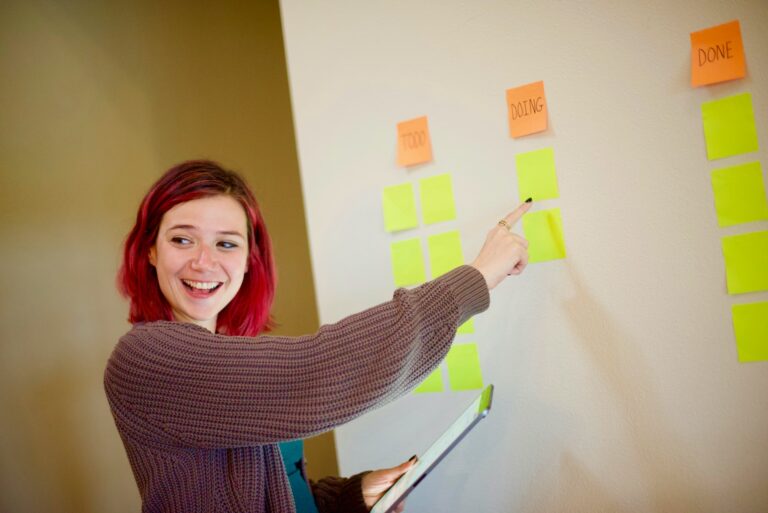Start Finishing by Charlie Gilkey | Book Summary
Introduction
Do you find that you are spending your personal resources on things that don’t really matter? You are not alone, as many people find themselves caught up in the grind, burdened by busywork, or simply exhausted.
However, make “someday” today as with a change in focus and perspective, you can work on and start finishing the projects that matter the most.
Buy Start Finishing on Amazon
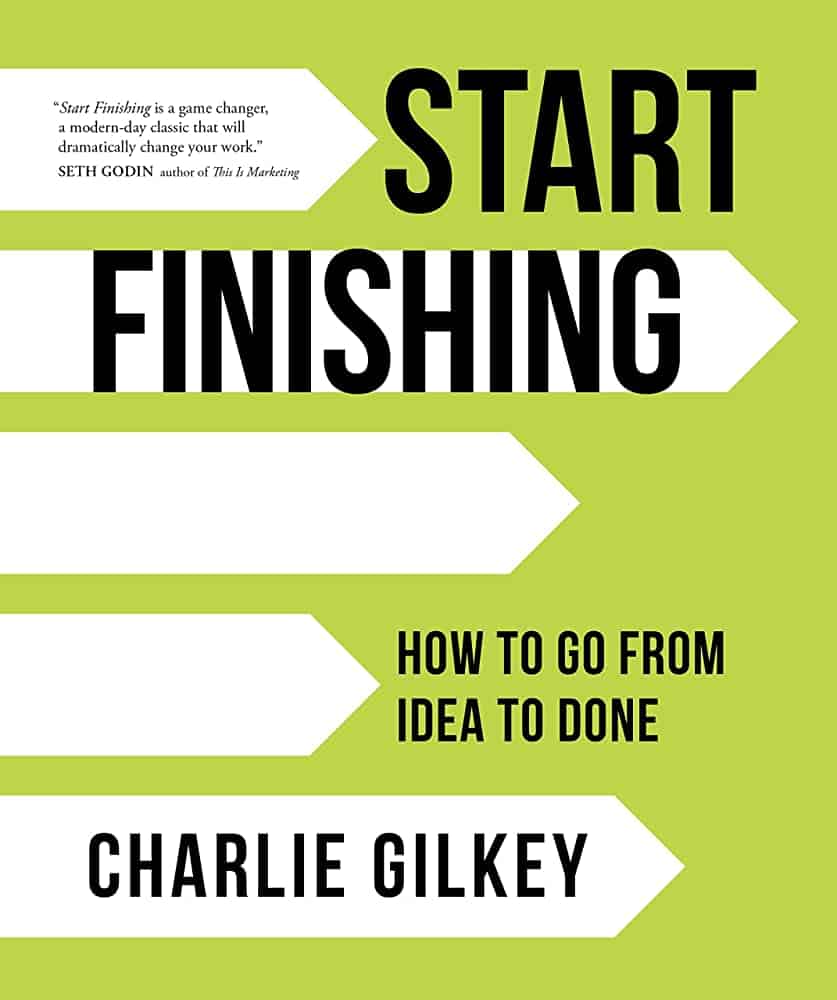
Start Finishing by Charlie Gilkey
How to Go From Idea to Done
In his book, Start Finishing, Charlie Gilkey presents a nine-step method for turning your idea into a project, taking action on it, and actually finishing it:
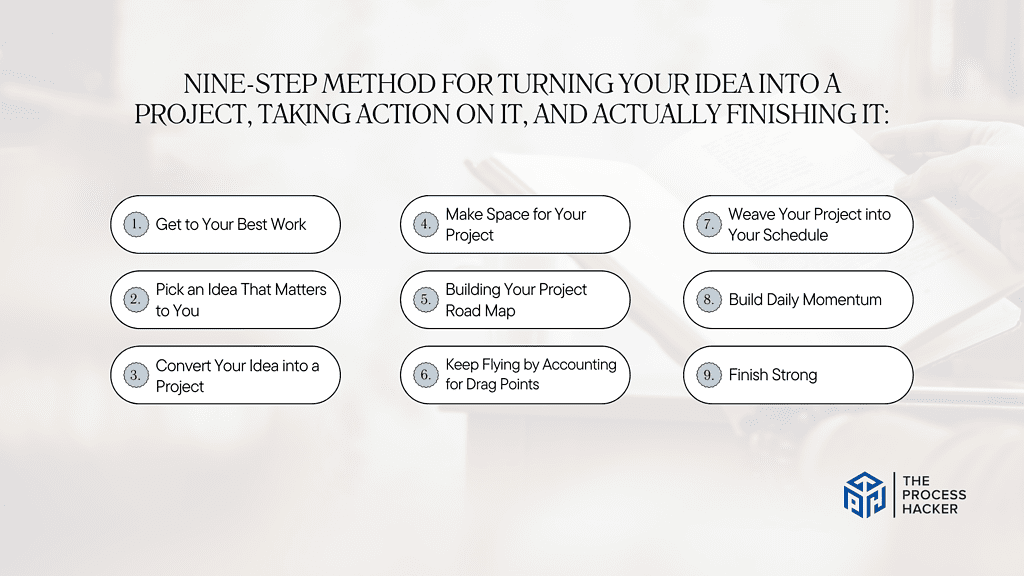
- Get to Your Best Work: Practice the five self-mastery keys, which include intention, awareness, boundaries, courage, and discipline.
- Pick an Idea That Matters to You: Continue working through the thrashing that comes along with any project that matters to you.
- Convert Your Idea into a Project: Establish your projects using SMART Goals, which stands for Simple, Meaningful, Actionable, Realistic, and Trackable.
- Make Space for Your Project: Create space for your project by prioritizing no more than five and making it doable by chunking, linking, and sequencing your ideas.
- Building Your Project Road Map: Create a project plan on a timeline using your GATES, including genius, affinities, talents, expertise, and strengths.
- Keep Flying by Accounting for Drag Points: Navigate through issues of head trash, no-win scenarios, and other people’s priorities.
- Weave Your Project into Your Schedule: Momentum plan your work to make adjustments, set up your environment for success, and eat your frogs.
- Build Daily Momentum: Enjoy the small wins, establish habits and routines, eliminate distractions and interruptions, and overcome project challenges.
- Finish Strong: Celebrate completion with others, review for future success, and channel the momentum into your next project.
Download the PDF Book Summary for Start Finishing
Part 1 – Clearing the Decks For Your Best Work
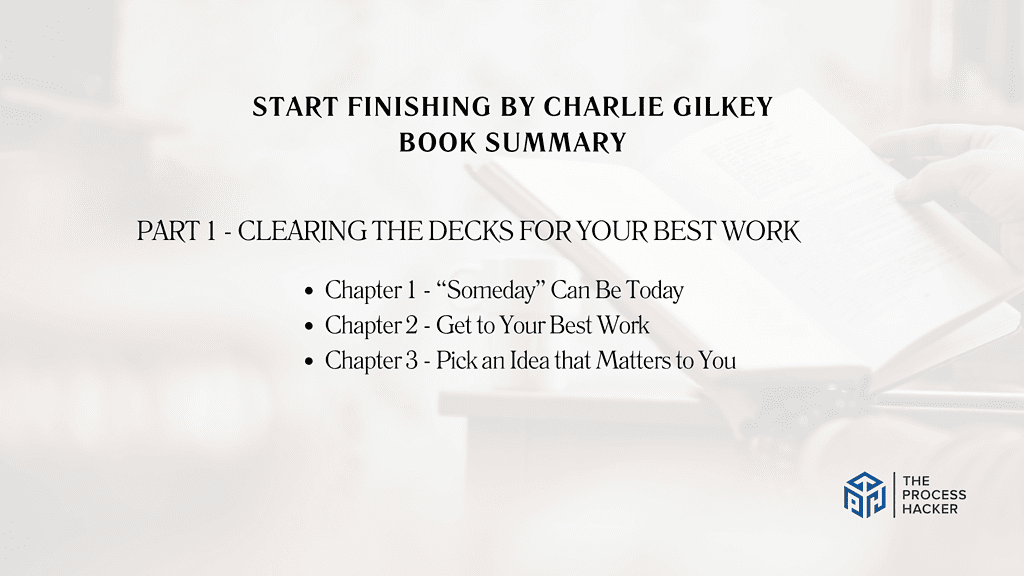
Chapter 1 – “Someday” Can Be Today
In Start Finishing, Gilkey found that most personal productivity books are focused on low-level tasks and the individual. He wrote the book, Start Finishing, to focus less on ideas and focus more on collaboration and the big picture perspective. We need to embrace projects to be more productive and to do our life’s best work:
Project – “anything that requires time, energy, and attention to complete”
We succeed in life when we take action by doing, especially working on the projects that involve our best work. Only we have the “set of experiences, expertise, skills, and perspectives to do” our best work, and we need to share this work with the world.
Projects can say a lot about ourselves, as they can be viewed as mirrors and bridges:
- Mirrors – “reflect back to us what is really going on in our inner and outer worlds”
- Bridges – “by doing the project, “we create the paths our souls want to walk”
“The primary consideration is thus not how your best work will support your livelihood but how your best work fits into a meaningful life for you.”
We can build the life that we went when we get rid of the idea that we personal imperfections that prevent us from doing our best work:
“You aren’t uniquely defective, you aren’t constitutionally wired to struggle, and you aren’t fated to be unable to get your shit together.”
We can divide our lives and careers into significant projects that take three to five years to complete. How many major projects do you have remaining in your life?
Chapter 2 – Get to Your Best Work
In Start Finishing, Gilkey argues that most of us are working on projects that are not in line with what we actually want and should be working on. This concept is conceptualized by the air sandwich:
Air Sandwich – “gap between your big picture and your day-to-day reality:”
- Top Slice – Consists of our vision, mission, purpose, and big goals
- Air – The five challenges that prevent us from doing our best work:
- Competing Priorities – We all have different roles in our lives that require our attention.
- Head Trash – We have demons, limiting beliefs, and cultural noise in our heads that drive us every day.
- No Realistic Plan – We have no useable method to get to where we want to go.
- Too Few Resources – We tell ourselves that we could do this if we had more time, money, or connections.
- Poor Team Alignment – We need our family, friends, coworkers, and community to be aligned and focused to help us with our goals.
- Bottom Slice – Consists of our day-to-day reality and grind
We can overcome the air sandwich by cultivating the five aspects (IABCD) of doing our best work:
- Intention – goal, purpose, or aim that we plan to carry out
- Awareness – state of knowing something, specifically ourselves
- Boundaries – guidelines that we set for others on how to treat us
- Courage – ability to do something that frightens us
- Discipline – self-control gained by enforcing order on ourselves
Chapter 3 – Pick an Idea that Matters to You
In Start Finishing, Gilkey argues that we need to do our best work and fully commit to it.
“The more something matters to you, the more you’ll thrash, precisely because its success or failure is deeply important to you:”
Thrash – “This emotional flailing and metalwork we do when we don’t fully commit to our best work…When we’re thrashing, we’re like the rocking chair that moves a lot but doesn’t actually get anywhere.”
When we don’t do our best work, we won’t be able to succeed and negatively affected by creative constipation:
Creative Constipation – “pain of not doing your best work”
We get inspired and fill our brains with ideas, but if we avoid getting those ideas out and doing our best work, we will be creatively constipated. We then can stagnate creatively and be in a toxic headspace.
Gilkey argues that we are made to solve problems or “slay dragons,” but failure is inevitable in the process of doing our best work. We are constrained by time, which can cause displacement:
Displacement – “the fact we are doing something now excludes doing anything else”
In economics, this is similar to the principle of opportunity cost, and it will help us prioritize the projects that matter most to us. We have to commit to our decision to work on a specific project but can let go of that project in the middle of it’s not allowing us to succeed. Also, we can defer projects for later as it may not be important right now.
Download the PDF Book Summary for Start Finishing
Part 2 – Planning Your Project

Chapter 4 – Convert Your Idea into a Project
In Start Finishing, Gilkey states that we have to take our idea and frame it as a SMART goal, which is different than the SMART framework that most people are used to:
- S – Simple – “help you know exactly what you need to do to move forward with the idea”
- M – Meaningful – provides you with a quick understanding of “the importance of completing that goal”
- A – Actionable – tells you “what action needs to be taken to accomplish that goal”
- R – Realistic – shows you that “the endpoint is achievable with the resources you have available”
- T – Trackable – tells you clearly “what progress means,” qualitatively or quantitatively; needs to establish start and end dates or it will not happen
We have to choose one of the three levels of success that is appropriate for that goal and match the level of effort and focus on the level of success we want:
- Small Success – requires very little effort, such as barely passing a test.
- Moderate Success – requires personal effort or resources, and you will journal about it.
- Epic Success – requires effort or resources beyond yourself, in which you leverage your Success Pack to achieve success.
We don’t have the time or energy to fulfill all our goals at the epic level. We need to not go at it alone and establish a Success Pack that is actively invested in our project:
Success Pack – “group of people who are going to be instrumentally involved in helping you push your best-work project to done,” which comprise of four types of people:
- Guides – people that you deeply respect and will help lead and navigate you to the goal
- Peers – “people at your approximate level of accomplishment or skill who can and will regularly contribute to your project”
- Supporters – “people who are doing work with and for you to help you get the project done”
- Beneficiaries – “people who will benefit from the completion of your work”
Chapter 5 – Make Space for Your Project
In Start Finishing, Gilkey argues that to finish our best-work projects, we need to create space by controlling time by using three important skills:
- Chunking – “splitting projects into coherent, doable parts”
- Linking – “joining chunks together so that they hang together”
- Sequencing – “linking chunks together into a logical order in space and time”
Chucks can be sized into years, quarters, months, weeks, days, hours, minutes, or seconds. These time divisions can be chunked, linked, or sequenced together to make up the project pyramid:
Project Pyramid – “shows how bigger projects contain smaller projects and how those smaller projects build momentum”
The pyramid can show us the why or purpose of a specific time scale (month) by looking up the pyramid to the next larger time scale (quarters). The pyramid can also show us the how or the actions required for executing the specific time block (months) by looking down the pyramid to the next smaller time scale (weeks).
Through his studies, Gilkey has concluded that most people are unable to finish no more than five projects per time period, which is codified in his rule:
Five Project Rule – “no more than five active projects per timescale”
The rule provides a constraint to prioritize and schedule projects, with the key to finishing major projects by focusing on the quarter time scale. For more on setting quarterly goals, check out the post on big rocks.
Weekly Block Schedule – We can organize time into four types of blocks on the weekly scale, as it is intuitive, easy to plan, and provides tangible constraints:
- Focus Blocks – 90-120 minute high-level work periods for creativity and focused work
- Social Blocks – 90-120 minute high-energy periods to interact with other people
- Admin Blocks – 30-60 minute low-level work periods
- Recovery Blocks – variable time periods for recharge activities for our mind and body
Our best work will be done during Focus Blocks, so it is recommended that we need a minimum of three focus blocks per week in order to avoid thrashing. This will help us move on our best-work projects with momentum, energy, and focus.
Chapter 6 – Build Your Project RoadMap
In Start Finishing, Gilkey helps us build our project roadmap to help us figure out how we will execute on finishing our best-work project:
Project Road Map – “project plan that chucks, links and sequences the project over time”
We should leverage our strengths (GATES) to execute and finish our projects:
- Genius – your inner creativity
- Affinities – the things that you are attracted to
- Talents – the natural skills and abilities that you possess
- Expertise – your knowledge gained through practice and experience
- Strengths – the things that are easy for you to do
Before we start building our Project Road Map, we need to account for the constraints of time and money. We need to establish a budget so we can use money as a tool to enhance our project but don’t spend beyond our means to compensate for things we don’t need. We need to establish deadlines to guide the projects, but it is the capacity of the time we are willing to spend that will drive our project to completion.
Lastly, when we have to collaborate on projects with others, we need to account for relay time:
Relay Time – “waiting time that happens every time a project changes hands”
Steps to Building Your Project Road Map:
- List – write down all of the chunks that make up your project
- Organize – sort and connect your chunks in an ordered manner
- Sequence – order your chunks in the order they need to be done
- Clump – group smaller chunks into the larger chunks that contain them
- Upgrade – check if you need to upgrade the clumps into the next larger time scale
- Overlay – layout chunks on a timeline that corresponds to the relevant time scale
- Schedule – schedule out the chunks using time blocks colored into a calendar
Chapter 7 – Keep Flying by Accounting for Drag Points
In Start Finishing, Gilkey argues that in order to maintain momentum in our best-work projects we need to account for drag points:
Drag Points – “natural places where reality will push against your plans”
We often run three scripts in our heads that prevent us from finishing our best work:
- Success Will Wreck My Relationships – I can only be successful to the detriment of the relationships with my partner, friends, and family.
- Success Versus Virtue – I can only be successful to the detriment of being a good person.
- What If I Can’t Do It Again – If I become successful once, I may not be able to replicate that success.
Most people tend to play it safe in the short term choosing mediocrity:
Mediocrity – “space between success and failure”
There will also be other people who can get in the way of us doing our best work, as they have their own priorities or can be naysayers or derailers. We should try to integrate Other People’s Priorities (OPP) to our benefit and for collaboration while limiting our interactions with haters, critics, or negative people.
Before we start a project, we can plan for the challenges that we could expect to face by doing a Project Premortem:
Project Premortem – “process of considering all the ways that a project might go south so you can actively work to prevent those things”
Download the PDF Book Summary for Start Finishing
Part 3 – Working The Plan
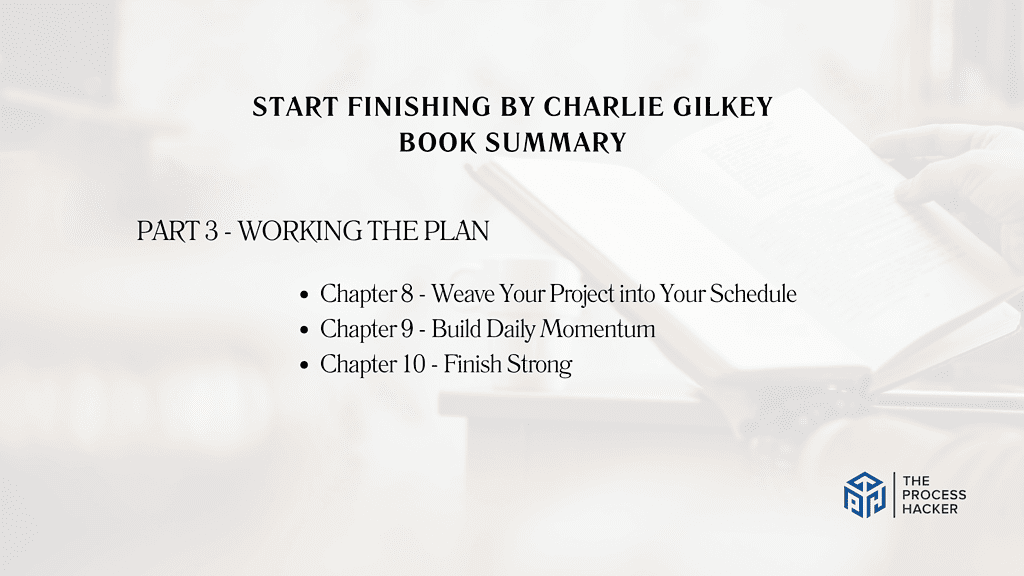
Chapter 8 – Weave Your Project into Your Schedule
In Start Finishing, Gilkey states that the plan to get our best-work project done comes from the Weekly Block Schedule, Five Projects Rule, and Project Road Map.
We can control our environment to work for us through the seven environmental factors:
- Sound – background noise that can range from dead silence to busy city intersection
- Smell – different smells can help you get into focus
- Sunlight – different amounts of light can range from a bright sunny day to pitch darkness
- Clothing – clothes can affect your comfortability or instill a work mentality
- Clutter or Organization – space that can range from being empty to very cluttered
- Amount of Space – the size of the room ranging from small to open spaces
- Music – can help you focus or be creative or maybe you can do without it
We can increase our efficiency by either batching or stacking work:
- Batching – “process of doing dissimilar kings of work in a contiguous stretch of time”
- Stacking – “process of doing dissimilar but compatible kinds of work in the same stretch of time”
We should address the frogs often or at the beginning of the day to reduce the amount of how much we dread our work:
Frogs – “tasks and chunks of projects that we really don’t want to do”
People have different levels of energy and focus throughout the day, so we need to do different types of work during the time blocks or days that are ideal to conduct that work. The work tends to move around during momentum planning:
Momentum Planning – “process of continually making and adjusting plans across all time perspectives”
Momentum Planning for a specific time scale (days) should be conducted in a time block prior to starting that next time scale. For daily planning, it is recommended to use the 5/10/15 framework for daily momentum:
- 5 – Five Projects Rule – limit to no more than 5 projects for that day
- 10 – 10-Minute Check-In – pre-work-day session to go over notes and start doing what you planned to do the night before
- 15 – 15-Minute Check-Out – post-work-day session to review the work done and plan for the next day
It is tempting to plan far in advance but it is not recommended as our plans will probably be wrong or likely to change, which can cause frustration and prematurely end the project.
Chapter 9 – Build Daily Momentum
In Start Finishing, Gilkey discusses the various ways that we work on our best work day in and day out to finish. We have to continually celebrate the small victories that will eventually lead to that major project completion.
We need to establish habits and routines to help project flow and limit decision fatigue:
- Habits – “single behaviors that are so ingrained that you have to inhibit doing those habits when their trigger is present”
- Routines – “behaviors that are consistently done in the same sequence or at the same time”
We need to reduce or eliminate interruptions and distractions:
- Interruption – “external diversions that keep us from doing our best work”
- Distraction – “internal diversions that we allow ourselves to do”
We need to prevent ourselves from getting stuck from the following patterns:
- Cascades – “pattern by which one project gets behind and causes other projects to get behind”
- Logjams – pattern “when you have too many parallel projects happening at once and you can’t finish all of them when you need to”
- Tarpits – “pattern wherein a project not only gets stuck, but the longer it stays stuck, the harder it is to pick it up again”
Lastly, when we have almost finished the project, we have to be mindful of the Creative Red Zone:
Creative Red Zone – “last stretch…where the closer you get to” finishing, it is more difficult to finish”
Chapter 10 – Finish Strong
In Start Finishing, Gilkey writes that even though we have finished our best-work project, there’s still some work to be done. We need to celebrate accordingly with our success pack. We should also take some time off of work before transitioning to the next major project.
An after-action review should be conducted to implement lessons learned from this project to improve the execution of the next project. And as projects can be messy, we should schedule some time to CAT:
- Clean Up – tidy up the messes made during the project
- Archive – decide what to keep and organize things for ease of use
- Trash – remove all the things that are unnecessary
Now that we have finished our best-work project, we have written our story and can pursue new opportunities.
Charlie Gilkey, Productivity Flourishing
This blog post was inspired by Charlie Gilkey’s talk about his book, “Start Finishing: How to Go From Idea to Done,” at ProductivityCon in Austin in early 2020.

Through his website and business, Charlie Gilkey helps people focus on what matters and execute on that vision through content, coaching, consulting, workshops, and products. He fosters a community of Creative Giants, which is “a growing group of doers with the vision to see how the world could be, the smarts to figure out how to make it happen, and the grit to do the work.
Download the PDF Book Summary for Start Finishing
Next Steps
I hope the book, Start Finishing, helps you make “someday” today, turn your ideas into reality, and start finishing on the projects that matter the most. I hope this book summary has inspired you to get your copy of Start Finishing.
If you are looking to start finishing in your small business, check out the book, Traction (book summary), by Gino Wickman. For more motivation and inspiration, check out our post on the best quotes on productivity.



